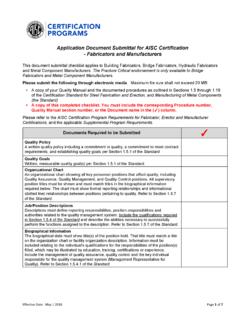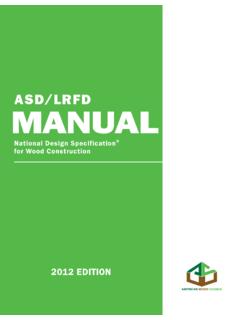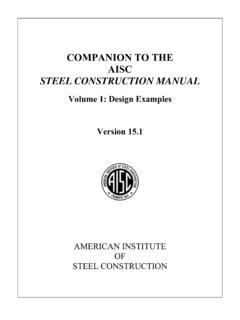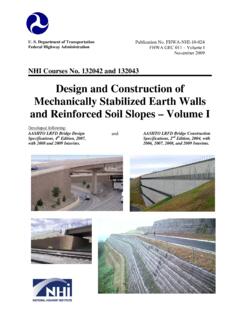Transcription of Simple Shear Connection Limit States - AISC Home
1 February 2008 MODERN STEEL CONSTRUCTION21 GSimple Shear Connection Limit StatessteelwiseFebruary 2008 Understanding Limit States is essential to understanding steel Connection design. Here s a look at common Limit States for Simple Shear o ur Connection toideas + answersGOOD Connection DESIGN IS aLL abOUT fOLLOwING LOaD ThROUGh aLL ThE ELE-MENTS IN ITS paTh. Load must be able to trans-fer from beam web to bolts to angles to more bolts and through to the supporting web. Each of these Connection elements has their own set of discrete Limit States . A quick review of these Limit States is a good check to make sure you are covering all your bases when designing.
2 The following is a list of references and also some examples of the most common Limit States to be checked on Simple Shear connections. bolt ShearSpecification Section = FnAb (J3-1) = (LRFD) = (ASD)additional references Manual Table 7-1; Specification Table Shear is based upon the Limit state of Shear rupture of the bolt. Equation J3-1 in Specification Section is general and applies to both tension and Shear in bolts. The nominal strengths for use in Equation J3-1 are obtained from Table The designer must know what bolt grade is to be used and whether he is including (N) or excluding (X) threads from the Shear plane.
3 It is conservative to design all cases assuming threads are included in the Shear plane. Table 7-15 in the Manual gives dimensions of high-strength fasteners. Threads can be present in the grip area between the nut or washer and the bolt head, but cannot be fully engaged at the interface of the two plies that are being joined by the Connection . A portion of one thread may be present at the Shear plane and still be considered excluded, as the strength of the full bolt diameter is present at this location. Eccen-tricity considerations for bolted connections have been noted in the included table.
4 Bolt bearing Specification Section = < (J3-6a)orRn = < (J3-6b) = (LRFD) = (ASD)additional referencesBearing strength based on bolt spacing (Gr. 50 and 36): Manual Table 7-5 Bearing strength based on edge distance (Gr. 50 and 36): Manual Table 7-6 Bolts bear both on the structural member and any Connection material (angles, plates, etc.). Hence, the equations in Section must be checked for both of these situations. The nominal strength equations evaluate bearing strength based on both edge distance and the deformation of a hole edge.
5 The lesser of these values will control your design. The edge distance value in the equation can be either the clear distance between adjacent bolt holes or between a bolt hole and the material edge. Section (a) gives two equations for the nominal strength of bolts bearing against the con-nection material. Equation J3-6a uses a factor of by erika WinterS-DoWney, , anD MattheW FaDDen figure 1. bolt threads are excluded from the Shear plane in this illustration. Erika Winters-Downey is an AISC regional engineer based in Kansas City.
6 Matthew Fad-den, a former AISC intern, is an engineering graduate student at the University of Michigan in Ann Arbor. MODERN STEEL CONSTRUCTION February 2008543also been applied in Tables in Part 10 of the Manual. block Shear RuptureSpecification Section = + UbsFuAnt < + UbsFuAnt (J4-5) = (LRFD) = (ASD)additional referencesManual Table 9-3 Block Shear is the tearing out of a block of material at a Connection as shown in Figure 2. Numerically, it is the sum of Shear yield or Shear rupture on a failure path parallel to the load and tension rupture perpendicular to the load.
7 It most often applies on coped beam sections, gusset plates, and angle legs. It also is applicable to the perimeter of welded connections, such as an angle welded to a gusset plate. Calculations have been simplified in the 2005 specification. The specification can be read as:Rn = Shear Rupture + Tension Rupture < Shear Yield + Tension Rupture Ubs in equation J4-5 is either 1 or and applies when deformation at the bolt hole at service load is a design consid-eration, and equation J3-6b uses a factor of and applies when deformation at the bolt hole is not a consideration.
8 How does the designer know if deformation at bolt holes is of concern? The answer to this question is linked to the development of the equations themselves. The expression is the original equation that was developed when rupture Limit States and deformation were first investigated. While this Limit state is correct, it was found that extensive deformation will occur before it is reached. The factor came about as a means to Limit deformation when nec-essary. The Commentary to the Specifica-tion does note that hole elongation of in.
9 Or more will likely be observed when the applied force is greater than It is up to the design engineer to evaluate whether this amount of hole deformation would be detrimental to the structure or Connection designs. Tables 7-5 and 7-6 in the Manual ( Available Bearing Strength at Bolt Holes Based on Bolt Spacing and Based on Edge Distance ) are based upon equation J3-6a. Shear YieldSpecification Section = (J4-3) = (LRFD) = (ASD)This Limit state is fairly straightforward. On a given Shear plane, the Shear yield strength of the gross section of the mate-rial must be greater than the applied load.
10 This Limit state applies to both bolted and welded connections. However, it is worth discussing the resistance factors and safety factors for LRFD and ASD as they apply to this Limit state in the 2005 specification. For LRFD the resis-tance factor, , is Previous editions of LRFD used a resistance factor of This is one area of the 2005 specification where LRFD has been altered to con-form to prior editions of ASD. One of the fundamental relationships in the 2005 specification between ASD and LRFD is that = ( is the safety factor for ASD design).
















